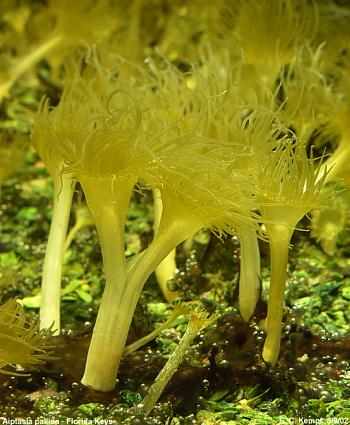
The weed anemone Aiptasia
PHOTO
Aiptasia pallida. Florida Keys. PHOTO: Steve Kempf
Species of the small brown sea anemone Aiptasia, including A. pallida and A. pulchella, are common "weed" organisms in zoo aquaria as well as those of the private hobbyist. This anemone is very well adapted for aquarium life for two reasons.
• It prefers high illumination because much of its nutrition is derived from millions of photosynthetic algal symbionts, called zooxanthellae , that live in the anemone's tissues.
• Its most common form of reproduction is asexual. This asexual reproduction is accomplished by a process called pedal laceration which simply means that small pieces of anemone tissue separate from the anemone as it slowly moves over objects in the aquarium, and each bit is able to grow into a complete new anemone. In small numbers, these anemones add interesting highlights to any tank; however if conditions are right the anemone can proliferate at a very high rate. As a result, regular and time consuming manual removal is often required so aquaria are not overrun by dense populations of Aiptasia.
One effective 'biological control' of this anemone has been an aeolid nudibranch which has been identified as the Mediterranean Berghia verrucicornis, but there is some uncertainty about the identification. See the Berghia verrucicornis - in aquaria Page for further information.
Authorship detailsRudman, W.B., 2002 (March 20) The weed anemone Aiptasia. [In] Sea Slug Forum. Australian Museum, Sydney. Available from http://www.seaslugforum.net/factsheet/aiptasia
Related messages
-
Re: Berghia verrucicornis - aquarium culture [2]
From: Stephen C. Kempf, June 11, 2007 -
Aiptasia fancier
From: Kerry Chase, February 25, 2004 -
Photo of Aiptasia from Florida
From: Stephen C. Kempf , March 22, 2002
